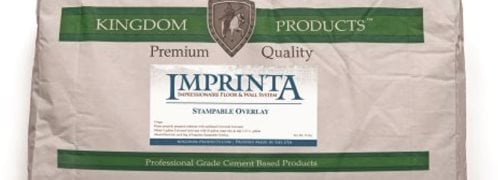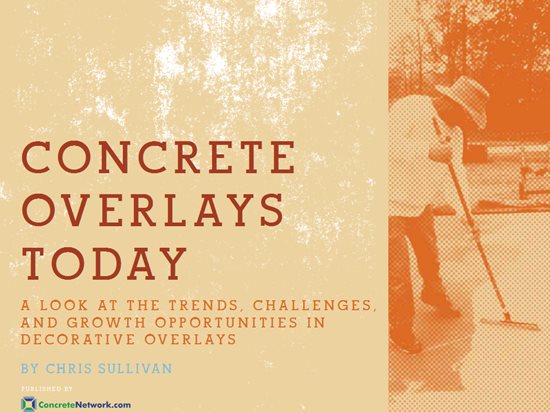- Concrete Overlays Home
- Get the Look - Interior Overlay Pictures
- When to Use a Polymer Overlay
- Comparison Chart of Overlay Systems: Which is best for your project?
- Five Factors to Consider when Choosing a Resurfacing System
- Concrete Overlay Reviews
- Types of Overlays
- Epoxy Coatings
- Microtoppings & Skim Coats
- Self-Leveling Overlays
- Spray-Down Toppings
- Polishable Overlays
- Stamped Concrete Overlays
- Preparing Concrete for Resurfacing
- Concrete Resurfacing
- Reducing Bond Failures Caused by Moisture-Vapor Transmission
- Don't Let Water Vapor Delaminate Your Overlay: How to seal concrete before an overlay
- How-To Tips for Installing Concrete Overlays
- Answers to Common Questions About Concrete Overlays: Advice from expert Chris Sullivan
- How to Add Color to Concrete Overlays
- How to Protect and Maintain Resurfaced Concrete
- Overlay Tools: Seven essential tools for concrete resurfacing
- Related Information
- Concrete Overlay Videos, with Bob Harris
- Decorative Concrete Overlays: A primer of the various overlay types and the decorative possibilities with each
- Vertical Concrete Overlays: Lightweight cement-based overlays mimic stone, brick, and other wall textures
Surface Preparation Trends in Decorative Overlays
Greater use of mechanical surface preparation methods is resulting in better overlay performanceThis is an excerpt from the new e-book “Concrete Overlays Today,” part of a series of reports from ConcreteNetwork.com on trends and insights about decorative concrete applications.
Free E-book:
Concrete Stamping Today
Discover seven rising trends in the overlay industry from ConcreteNetwork.com’s new e-book. You’ll get insights and advice from veteran overlay installers that will help you find success in today’s market.
Download Concrete Overlays Today (PDF)
No matter what type of overlay work you do, the one universal constant in the industry is the need for good surface preparation. It is hands down the most important part of any overlay project and is critical to long-term performance. The trends with surface preparation have less to do with new processes and more to do with greater emphasis on actually performing proper surface preparation. “Almost all the surface preparation we do for overlay projects involves grinding with diamond cup wheels or diamond pads,” says Chris Becker, managing director of the architectural concrete division of Stockness Construction, Hugo, Minn. Every expert installer I spoke with agreed that mechanical surface preparation is the way to go, and is what they themselves do. This is a change from 10 years ago, when most installers would rely on acid etching, chemical cleaners and power washing to do the job.
Why the trend toward more thorough surface preparation? “Contractors own more large [grinding] equipment because of the popularity of polished concrete, and it can be used for surface preparation,” suggests Terry Grimble, director of technical services for Bomanite Company. The impact of years of education from the supply side of the overlay business must also be acknowledged. Trevor Foster, western sales manager with Miracote Products, has been teaching overlay application and proper surface preparation techniques for years, and says that 90% of all overlays require a surface profile of CSP 3 or better, as recommended by the International Concrete Repair Institute Concrete.
Contractors have been hearing how important proper surface preparation is for years, and it is starting to resonate with the industry. We have seen the effects of poor surface preparation, and no one wants to go back to the days of constant overlay failures. Along with more installers owning grinding equipment, or at least having access to it, is the fact that grinding technology has also improved. Equipment manufacturers have jumped on board with better diamonds, more efficient grinding and scarifying machines, and advances in dust collection. To be sure, the equipment can cost big bucks. But it can also prepare thousands of square feet per hour and ensure better overlay performance.
The trend is not only to use the right equipment, but also to use a better system of primers and repair products. Ryan Connors, owner of Modern Concrete Surfaces, Signal Hill, Calif., uses a moisture-block epoxy primer seeded with sand on most of his decorative overlay projects. “We see a trend toward better prep and moisture control,” he says. Some installers will include the cost of a moisture-control system in their price for surface preparation, knowing that a callback because of a delaminating failure caused by moisture is much worse than the upfront cost per square foot for a moisture-control epoxy primer.
Installers are also changing the way they deal with cracks and patching. Gone are the days of filling cracks with caulk and hoping for the best. Becker uses a two-part rigid epoxy crack filler. “We clean the cracks, backfill if needed with sand, and then fill them with the epoxy material. Once that cures, we then profile the entire floor mechanically,” he says. Rapid-setting cement-based repair mortars and patching compounds are also popular. Grimble has been promoting these materials to the installers in the Bomanite network for years. He likes polyurea and water-thin polyurethane crack repair products that can be bulked up with sand if needed, as well as rapid-setting polymer-modified cement systems for patching popouts and voids prior to priming the surface. “In today’s world, people want fast turnaround,” he says.
The market is also seeing more overlay use for new construction, for both interior and exterior work. Some projects find it more cost-effective to place a rough-base concrete slab that they don’t have to worry about protecting during build-out. Once the general construction is complete and the detail finish work begins, overlays are applied to create the final decorative flooring. This construction method can be seen in many of the large resort hotels in Las Vegas. The large expanses of decorative streetscapes and stone work in Caesars Palace and The Venetian are decorative overlays that were installed near the end of the construction process.
Related information:
Surface Preparation
Concrete Overlays
Return to Concrete Overlays Today
 Rapid Set Skim Coat
Repairs, levels, and smooths concrete for applications.
Rapid Set Skim Coat
Repairs, levels, and smooths concrete for applications.
 Thin Micro-Topping
Produces durable surface to color or stain
Thin Micro-Topping
Produces durable surface to color or stain
 Self Leveling Overlay
Find the overlay to meet your project's needs
Self Leveling Overlay
Find the overlay to meet your project's needs
 T1000 Stampable Overlay
For use with resurfacing concrete floors and hardscapes.
T1000 Stampable Overlay
For use with resurfacing concrete floors and hardscapes.
 Flooring & Coating System
Epoxy Flooring System designed for concrete
Flooring & Coating System
Epoxy Flooring System designed for concrete
 Stamped Concrete Overlay
Warm weather and cold weather formulas
Stamped Concrete Overlay
Warm weather and cold weather formulas
 HellFire® Concrete Coating
Chemical & heat resistance
HellFire® Concrete Coating
Chemical & heat resistance
 Imprinta Stampable Overlay
2-component system
Imprinta Stampable Overlay
2-component system





